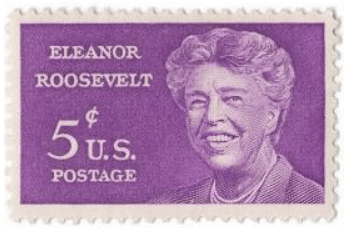Eleanor Roosevelt was the first woman to hold a press conference as a First Lady. She was also the first First Lady to write a newspaper column, or speak at a national convention.
Eleanor Roosevelt was educated at the Allenswood Girl’s Academy in London where Marie Souvestre taught girls languages, literature, writing, and the arts. There were no classes in history, geography or philosophy, but Marie Souvestre gave Eleanor private lessons in those topics. It was here the orphaned girl’s interest in politics began and it was here that she began to find her voice.
Uncomfortable with the debutante expectations of her social standing, Eleanor had already begun working on social issues before she married her fifth cousin, once-removed, Franklin Delano Roosevelt. At the wedding, her uncle President Theodore Roosevelt walked her down the aisle on March 17, 1905, foregoing a scheduled appearance in the St. Patrick’s Day parade in New York City.
When her husband was appointed Assistant Navy Secretary, Eleanor learned about Washington politics and began to engage other wives in social issues. She was instrumental during this time in promoting better health care for returning seamen.
When she learned that her husband was having an affair with Lucy Mercer, her personal secretary, Eleanor offered Franklin a divorce, but Franklin’s mother told him his political career would be ruined if he divorced, especially if he then married a Catholic woman. She threatened to disinherit him and he capitulated, setting his affair aside, at least for a period of time. (When Franklin died, Lucy Mercer was at his side.)
When Franklin ran as Vice President, in 1921, he lost, but the education Eleanor received from journalist Louis Howe about political machinations was indispensable to her future. She learned how the media could be used for politics and for political agendas.
Franklin contracted polio after his campaign, and Eleanor tended him personally for a time. It was she who convinced him not to abandon politics. Then, fortuitously, one of Franklin’s secretaries took over household duties for him: from paying bills to entertainment, freeing Eleanor from mundane responsibilities and setting her on a path of freedom to explore her social interests.
As First Lady of New York, after her husband was elected governor, Eleanor continued a career she had already established, promoting social causes by writing for magazines and newspapers and hosting the five-day a week radio program “Women in Politics,” carried on NBC radio. During this time her husband’s limitations often prevented his travel and she began to make public appearances on his behalf.
Eleanor Roosevelt gave her first press conference as First Lady two days after she entered the White House and gave her last just hours before her husband’s sudden death. The press conferences were intended to promote causes of concern to her, but the White House also used her conferences to release information they thought might be better received from Eleanor than from others in the administration. Eleanor had another purpose for the press conferences: the employment of women reporters during the Depression. All male reporters, even from major outlets, were barred from her press conferences, so newspapers and wire services were coerced into hiring women.
During Franklin’s presidency Eleanor wrote regular magazine articles for Women’s Home Companion, Ladies’ Home Journal, and had a five-year contract with McCall’s. She had a daily newspaper column, “My Day,” in 62 newspapers with over 4 million readers. It was in this column that she explained that she had resigned from the Daughters of the American Revolution because the organization would not lease their auditorium for a concert by Marian Anderson, an African-American contralto. Eleanor, along with her husband, later arranged for Marian Anderson to sing on the steps of the Lincoln Memorial.
From her son, James, who worked for Sam Goldwyn, Eleanor learned the power of motion pictures and allowed many of her activities to be documented on film. In 1933 a Paramount News report showed Eleanor traveling by airplane, the first incumbent First Lady to do so. The headline “A First Lady Flies!” was carried in theaters across the nation. In addition to all her writing, and her radio shows, Eleanor wrote many books, including a three-volume autobiography.
After her husband’s death Eleanor served as a delegate to the United Nations, appointed first by Harry Truman, and later by John Kennedy. She chaired the UN’s Human Rights Commission and the Commission on the Status of Women. She considered the Universal Declaration of Human Rights approved by the United Nations one of her greatest accomplishments.
Eleanor Roosevelt’s funeral was attended by a former First Lady, Bess Truman; a current First Lady, Jacqueline Kennedy; and a future First Lady, Lady Bird Johnson. Also in attendance were President Kennedy and former Presidents Truman and Eisenhower.
LEARN MORE:
Read Eleanor Roosevelt’s Three-Volume Autobiography: This Is My Story (1937), This I Remember (1949), On My Own (1958)

